University: Individual Development in HSC Workplace Report, Semester 1
VerifiedAdded on 2021/04/16
|12
|2648
|54
Report
AI Summary
This report delves into the critical aspects of managing human resources within the Health and Social Care (HSC) sector, focusing on individual development. It explores various methods for monitoring individual performance, including developmental outcomes, training, and feedback mechanisms. The report identifies the need for training through monitoring individual's performance, career development planning, changing personal circumstances. It analyzes strategies for promoting individual development, such as competence against occupational standards, training versus education, partnerships, and compliance with external requirements. Furthermore, the report examines leadership theories applicable to the HSC workplace, including transactional and transformational leadership, as well as the importance of emotional intelligence. It also analyzes how working relationships can be effectively managed and evaluates the author's own development and management experiences. The conclusion emphasizes the significance of individual development tools and strategies in enhancing employee effectiveness within the HSC setting.
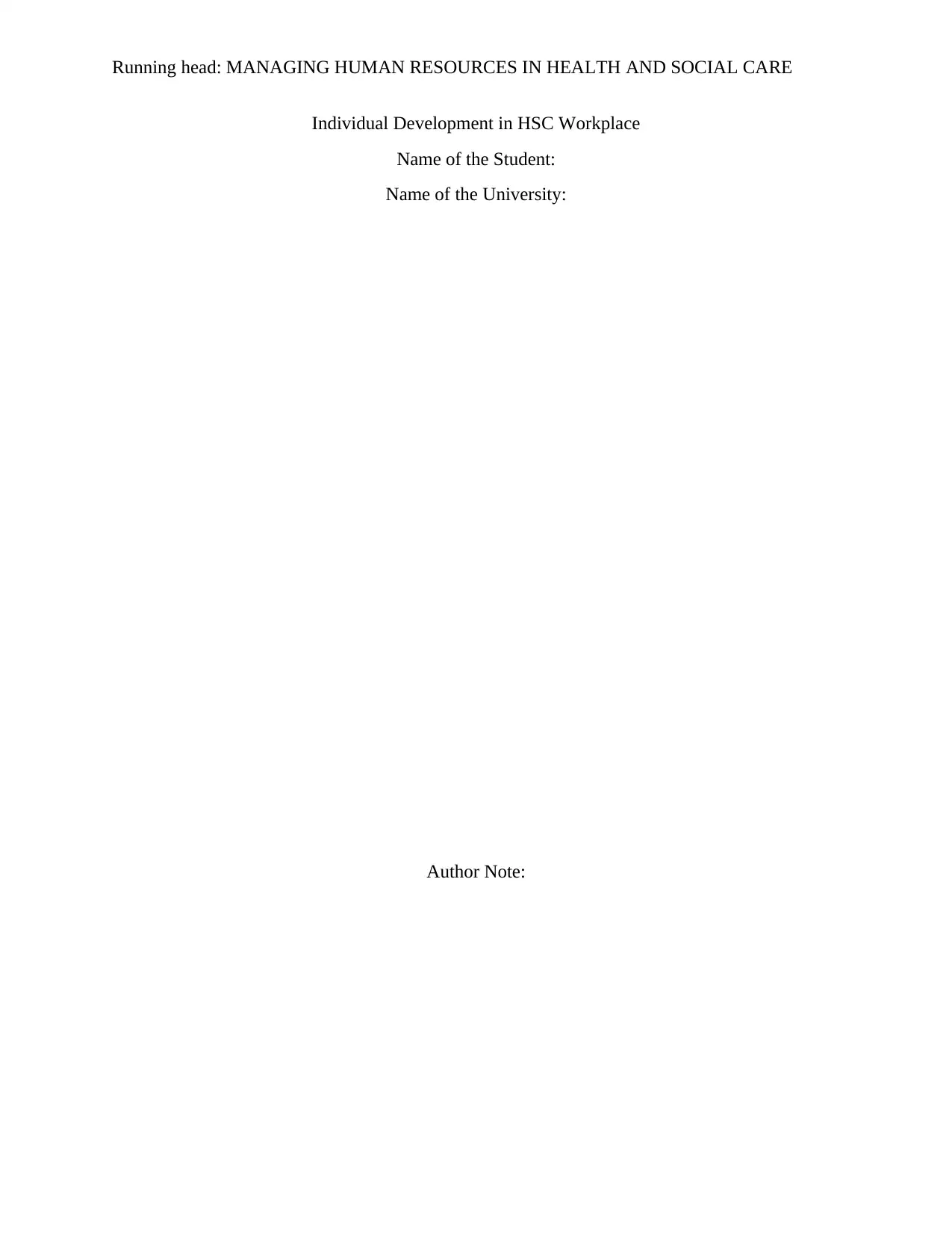
Running head: MANAGING HUMAN RESOURCES IN HEALTH AND SOCIAL CARE
Individual Development in HSC Workplace
Name of the Student:
Name of the University:
Author Note:
Individual Development in HSC Workplace
Name of the Student:
Name of the University:
Author Note:
Secure Best Marks with AI Grader
Need help grading? Try our AI Grader for instant feedback on your assignments.
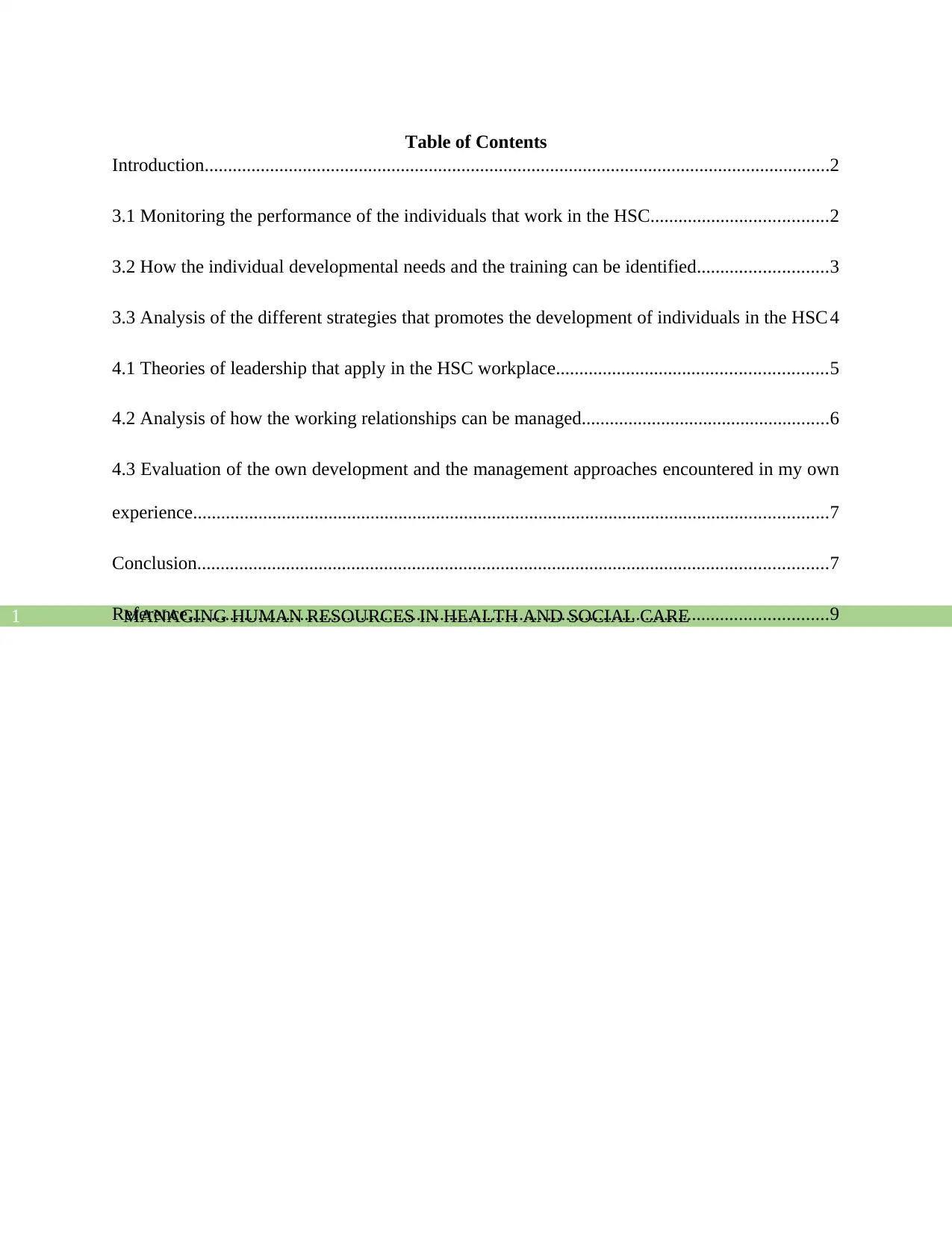
MANAGING HUMAN RESOURCES IN HEALTH AND SOCIAL CARE1
Table of Contents
Introduction......................................................................................................................................2
3.1 Monitoring the performance of the individuals that work in the HSC......................................2
3.2 How the individual developmental needs and the training can be identified............................3
3.3 Analysis of the different strategies that promotes the development of individuals in the HSC 4
4.1 Theories of leadership that apply in the HSC workplace..........................................................5
4.2 Analysis of how the working relationships can be managed.....................................................6
4.3 Evaluation of the own development and the management approaches encountered in my own
experience........................................................................................................................................7
Conclusion.......................................................................................................................................7
Reference.........................................................................................................................................9
Table of Contents
Introduction......................................................................................................................................2
3.1 Monitoring the performance of the individuals that work in the HSC......................................2
3.2 How the individual developmental needs and the training can be identified............................3
3.3 Analysis of the different strategies that promotes the development of individuals in the HSC 4
4.1 Theories of leadership that apply in the HSC workplace..........................................................5
4.2 Analysis of how the working relationships can be managed.....................................................6
4.3 Evaluation of the own development and the management approaches encountered in my own
experience........................................................................................................................................7
Conclusion.......................................................................................................................................7
Reference.........................................................................................................................................9
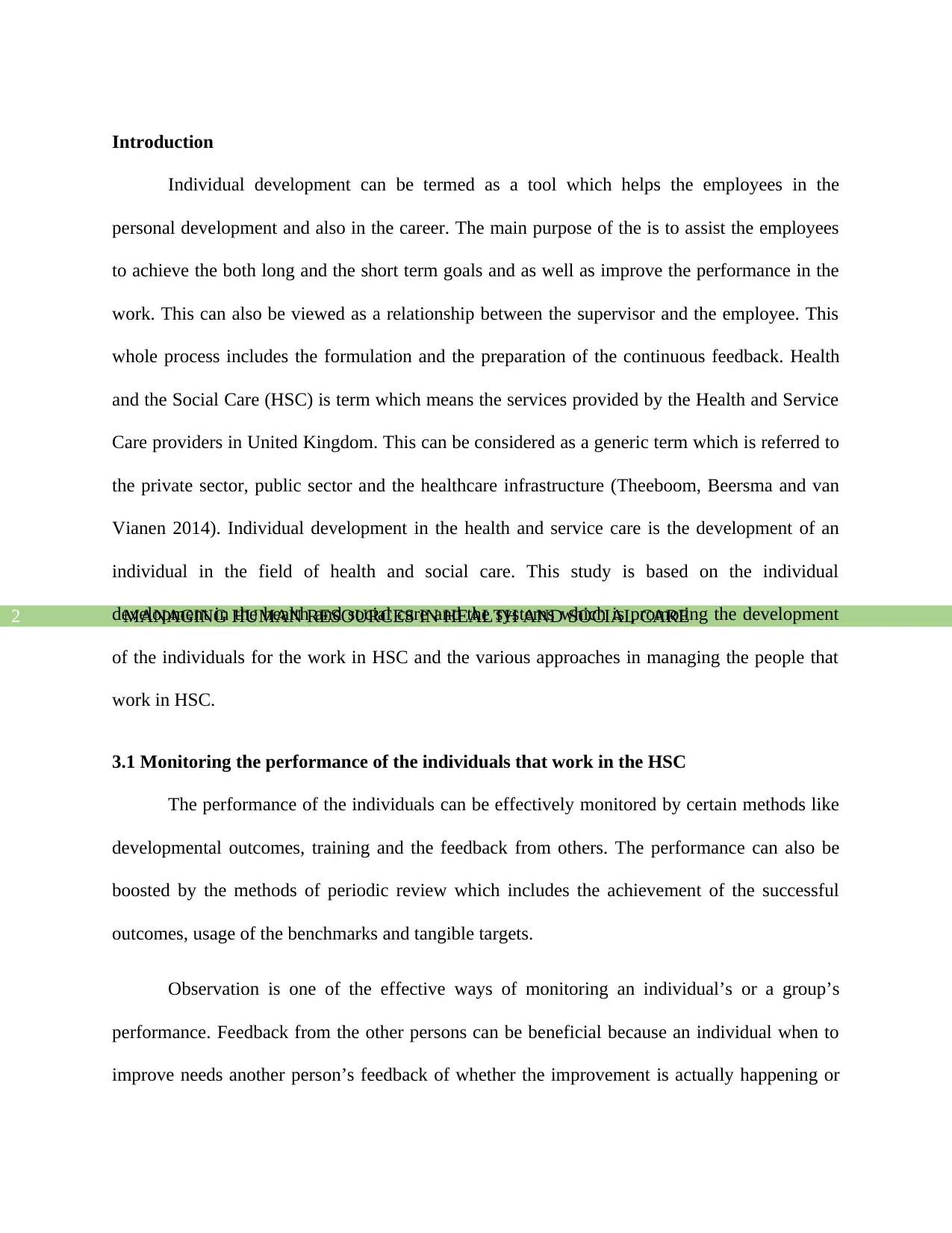
MANAGING HUMAN RESOURCES IN HEALTH AND SOCIAL CARE2
Introduction
Individual development can be termed as a tool which helps the employees in the
personal development and also in the career. The main purpose of the is to assist the employees
to achieve the both long and the short term goals and as well as improve the performance in the
work. This can also be viewed as a relationship between the supervisor and the employee. This
whole process includes the formulation and the preparation of the continuous feedback. Health
and the Social Care (HSC) is term which means the services provided by the Health and Service
Care providers in United Kingdom. This can be considered as a generic term which is referred to
the private sector, public sector and the healthcare infrastructure (Theeboom, Beersma and van
Vianen 2014). Individual development in the health and service care is the development of an
individual in the field of health and social care. This study is based on the individual
development in the health and social care and the systems which is promoting the development
of the individuals for the work in HSC and the various approaches in managing the people that
work in HSC.
3.1 Monitoring the performance of the individuals that work in the HSC
The performance of the individuals can be effectively monitored by certain methods like
developmental outcomes, training and the feedback from others. The performance can also be
boosted by the methods of periodic review which includes the achievement of the successful
outcomes, usage of the benchmarks and tangible targets.
Observation is one of the effective ways of monitoring an individual’s or a group’s
performance. Feedback from the other persons can be beneficial because an individual when to
improve needs another person’s feedback of whether the improvement is actually happening or
Introduction
Individual development can be termed as a tool which helps the employees in the
personal development and also in the career. The main purpose of the is to assist the employees
to achieve the both long and the short term goals and as well as improve the performance in the
work. This can also be viewed as a relationship between the supervisor and the employee. This
whole process includes the formulation and the preparation of the continuous feedback. Health
and the Social Care (HSC) is term which means the services provided by the Health and Service
Care providers in United Kingdom. This can be considered as a generic term which is referred to
the private sector, public sector and the healthcare infrastructure (Theeboom, Beersma and van
Vianen 2014). Individual development in the health and service care is the development of an
individual in the field of health and social care. This study is based on the individual
development in the health and social care and the systems which is promoting the development
of the individuals for the work in HSC and the various approaches in managing the people that
work in HSC.
3.1 Monitoring the performance of the individuals that work in the HSC
The performance of the individuals can be effectively monitored by certain methods like
developmental outcomes, training and the feedback from others. The performance can also be
boosted by the methods of periodic review which includes the achievement of the successful
outcomes, usage of the benchmarks and tangible targets.
Observation is one of the effective ways of monitoring an individual’s or a group’s
performance. Feedback from the other persons can be beneficial because an individual when to
improve needs another person’s feedback of whether the improvement is actually happening or
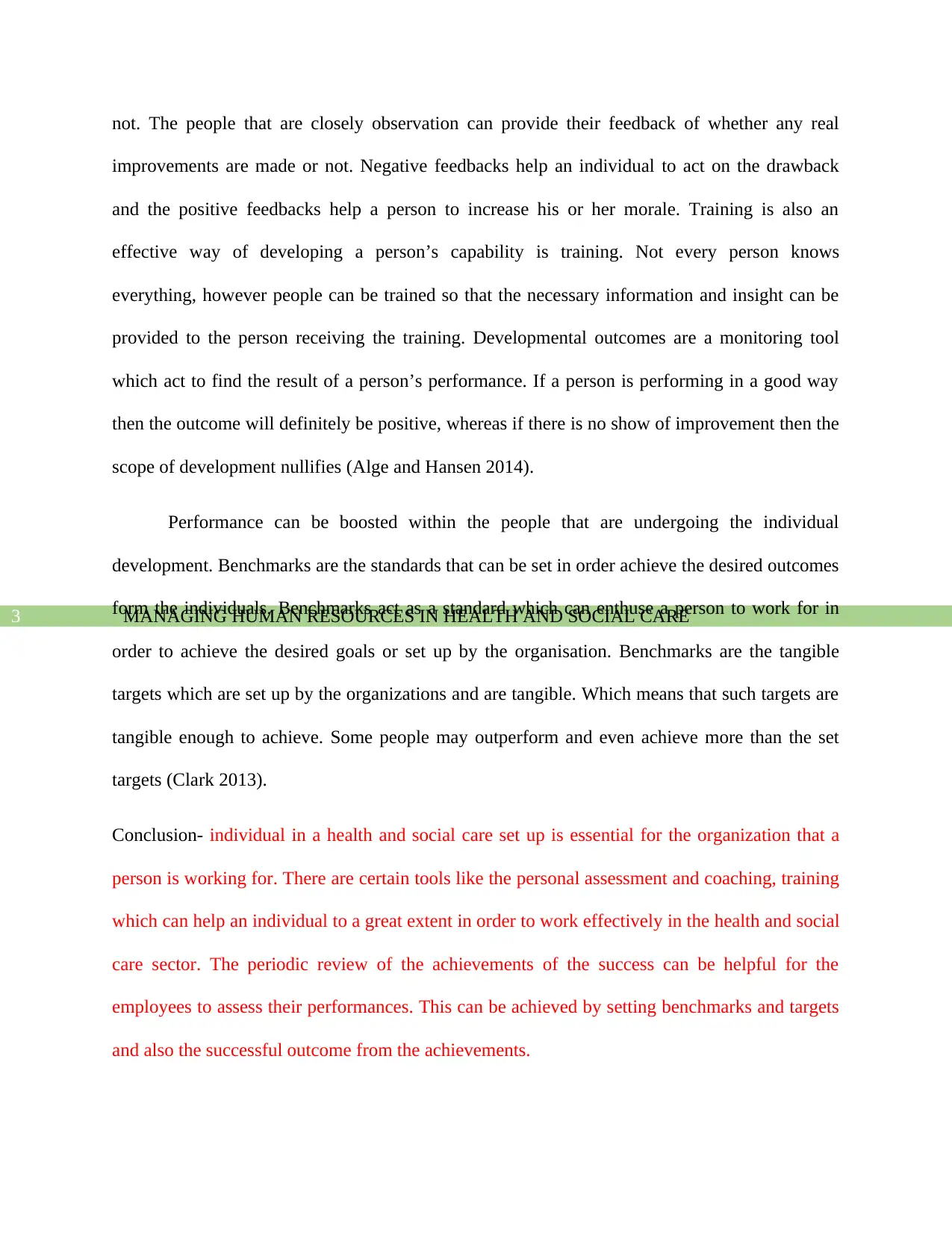
MANAGING HUMAN RESOURCES IN HEALTH AND SOCIAL CARE3
not. The people that are closely observation can provide their feedback of whether any real
improvements are made or not. Negative feedbacks help an individual to act on the drawback
and the positive feedbacks help a person to increase his or her morale. Training is also an
effective way of developing a person’s capability is training. Not every person knows
everything, however people can be trained so that the necessary information and insight can be
provided to the person receiving the training. Developmental outcomes are a monitoring tool
which act to find the result of a person’s performance. If a person is performing in a good way
then the outcome will definitely be positive, whereas if there is no show of improvement then the
scope of development nullifies (Alge and Hansen 2014).
Performance can be boosted within the people that are undergoing the individual
development. Benchmarks are the standards that can be set in order achieve the desired outcomes
form the individuals. Benchmarks act as a standard which can enthuse a person to work for in
order to achieve the desired goals or set up by the organisation. Benchmarks are the tangible
targets which are set up by the organizations and are tangible. Which means that such targets are
tangible enough to achieve. Some people may outperform and even achieve more than the set
targets (Clark 2013).
Conclusion- individual in a health and social care set up is essential for the organization that a
person is working for. There are certain tools like the personal assessment and coaching, training
which can help an individual to a great extent in order to work effectively in the health and social
care sector. The periodic review of the achievements of the success can be helpful for the
employees to assess their performances. This can be achieved by setting benchmarks and targets
and also the successful outcome from the achievements.
not. The people that are closely observation can provide their feedback of whether any real
improvements are made or not. Negative feedbacks help an individual to act on the drawback
and the positive feedbacks help a person to increase his or her morale. Training is also an
effective way of developing a person’s capability is training. Not every person knows
everything, however people can be trained so that the necessary information and insight can be
provided to the person receiving the training. Developmental outcomes are a monitoring tool
which act to find the result of a person’s performance. If a person is performing in a good way
then the outcome will definitely be positive, whereas if there is no show of improvement then the
scope of development nullifies (Alge and Hansen 2014).
Performance can be boosted within the people that are undergoing the individual
development. Benchmarks are the standards that can be set in order achieve the desired outcomes
form the individuals. Benchmarks act as a standard which can enthuse a person to work for in
order to achieve the desired goals or set up by the organisation. Benchmarks are the tangible
targets which are set up by the organizations and are tangible. Which means that such targets are
tangible enough to achieve. Some people may outperform and even achieve more than the set
targets (Clark 2013).
Conclusion- individual in a health and social care set up is essential for the organization that a
person is working for. There are certain tools like the personal assessment and coaching, training
which can help an individual to a great extent in order to work effectively in the health and social
care sector. The periodic review of the achievements of the success can be helpful for the
employees to assess their performances. This can be achieved by setting benchmarks and targets
and also the successful outcome from the achievements.
Secure Best Marks with AI Grader
Need help grading? Try our AI Grader for instant feedback on your assignments.
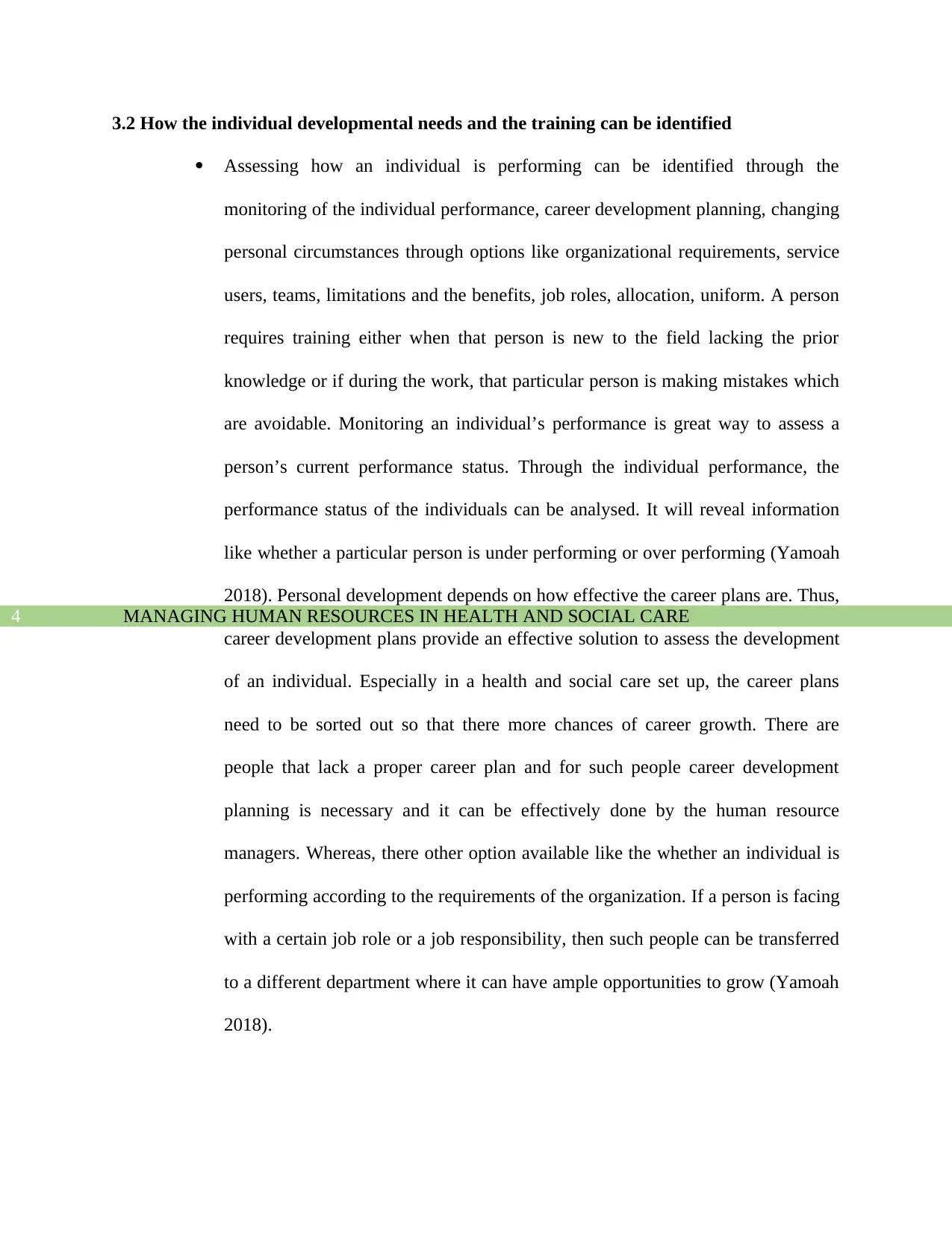
MANAGING HUMAN RESOURCES IN HEALTH AND SOCIAL CARE4
3.2 How the individual developmental needs and the training can be identified
Assessing how an individual is performing can be identified through the
monitoring of the individual performance, career development planning, changing
personal circumstances through options like organizational requirements, service
users, teams, limitations and the benefits, job roles, allocation, uniform. A person
requires training either when that person is new to the field lacking the prior
knowledge or if during the work, that particular person is making mistakes which
are avoidable. Monitoring an individual’s performance is great way to assess a
person’s current performance status. Through the individual performance, the
performance status of the individuals can be analysed. It will reveal information
like whether a particular person is under performing or over performing (Yamoah
2018). Personal development depends on how effective the career plans are. Thus,
career development plans provide an effective solution to assess the development
of an individual. Especially in a health and social care set up, the career plans
need to be sorted out so that there more chances of career growth. There are
people that lack a proper career plan and for such people career development
planning is necessary and it can be effectively done by the human resource
managers. Whereas, there other option available like the whether an individual is
performing according to the requirements of the organization. If a person is facing
with a certain job role or a job responsibility, then such people can be transferred
to a different department where it can have ample opportunities to grow (Yamoah
2018).
3.2 How the individual developmental needs and the training can be identified
Assessing how an individual is performing can be identified through the
monitoring of the individual performance, career development planning, changing
personal circumstances through options like organizational requirements, service
users, teams, limitations and the benefits, job roles, allocation, uniform. A person
requires training either when that person is new to the field lacking the prior
knowledge or if during the work, that particular person is making mistakes which
are avoidable. Monitoring an individual’s performance is great way to assess a
person’s current performance status. Through the individual performance, the
performance status of the individuals can be analysed. It will reveal information
like whether a particular person is under performing or over performing (Yamoah
2018). Personal development depends on how effective the career plans are. Thus,
career development plans provide an effective solution to assess the development
of an individual. Especially in a health and social care set up, the career plans
need to be sorted out so that there more chances of career growth. There are
people that lack a proper career plan and for such people career development
planning is necessary and it can be effectively done by the human resource
managers. Whereas, there other option available like the whether an individual is
performing according to the requirements of the organization. If a person is facing
with a certain job role or a job responsibility, then such people can be transferred
to a different department where it can have ample opportunities to grow (Yamoah
2018).
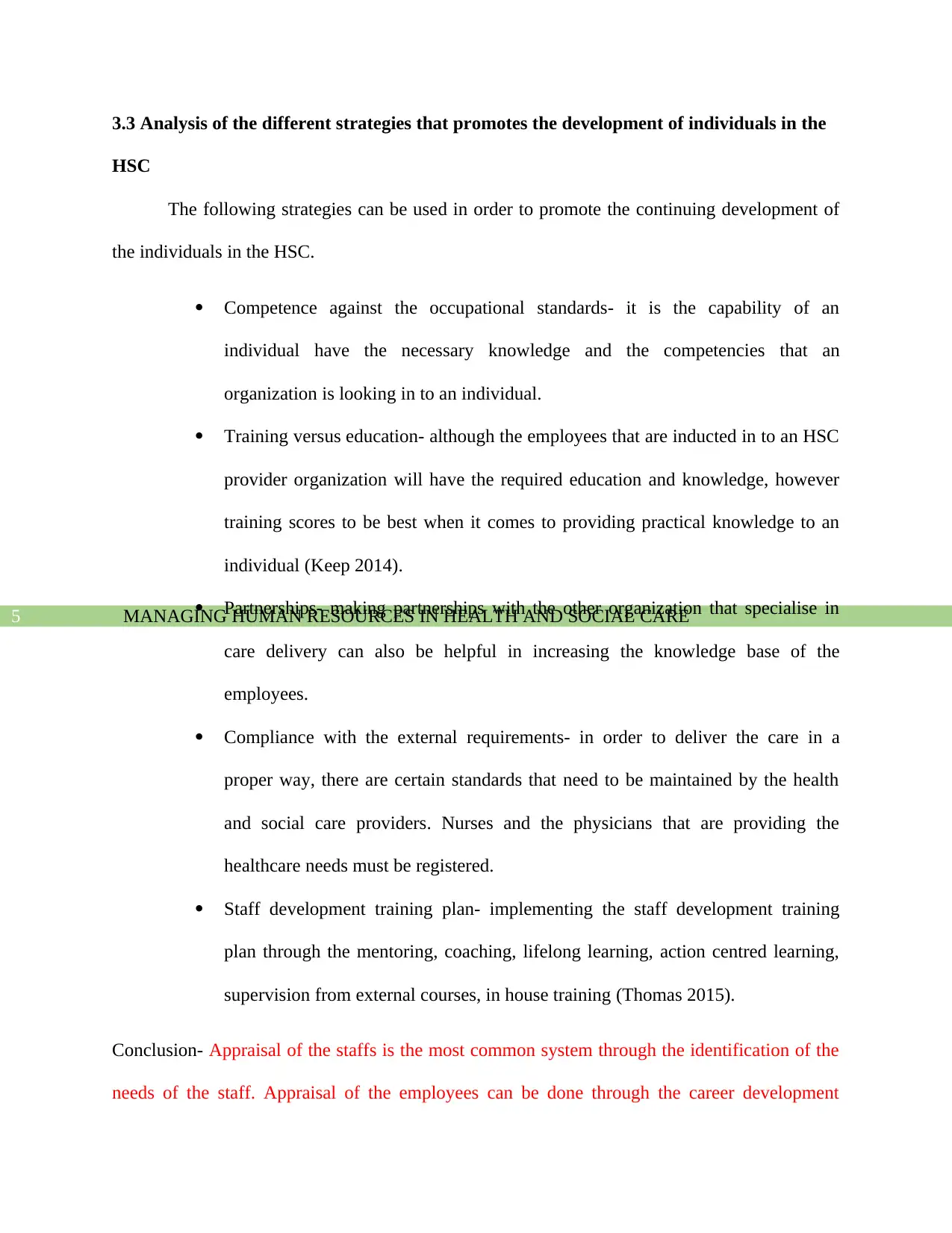
MANAGING HUMAN RESOURCES IN HEALTH AND SOCIAL CARE5
3.3 Analysis of the different strategies that promotes the development of individuals in the
HSC
The following strategies can be used in order to promote the continuing development of
the individuals in the HSC.
Competence against the occupational standards- it is the capability of an
individual have the necessary knowledge and the competencies that an
organization is looking in to an individual.
Training versus education- although the employees that are inducted in to an HSC
provider organization will have the required education and knowledge, however
training scores to be best when it comes to providing practical knowledge to an
individual (Keep 2014).
Partnerships- making partnerships with the other organization that specialise in
care delivery can also be helpful in increasing the knowledge base of the
employees.
Compliance with the external requirements- in order to deliver the care in a
proper way, there are certain standards that need to be maintained by the health
and social care providers. Nurses and the physicians that are providing the
healthcare needs must be registered.
Staff development training plan- implementing the staff development training
plan through the mentoring, coaching, lifelong learning, action centred learning,
supervision from external courses, in house training (Thomas 2015).
Conclusion- Appraisal of the staffs is the most common system through the identification of the
needs of the staff. Appraisal of the employees can be done through the career development
3.3 Analysis of the different strategies that promotes the development of individuals in the
HSC
The following strategies can be used in order to promote the continuing development of
the individuals in the HSC.
Competence against the occupational standards- it is the capability of an
individual have the necessary knowledge and the competencies that an
organization is looking in to an individual.
Training versus education- although the employees that are inducted in to an HSC
provider organization will have the required education and knowledge, however
training scores to be best when it comes to providing practical knowledge to an
individual (Keep 2014).
Partnerships- making partnerships with the other organization that specialise in
care delivery can also be helpful in increasing the knowledge base of the
employees.
Compliance with the external requirements- in order to deliver the care in a
proper way, there are certain standards that need to be maintained by the health
and social care providers. Nurses and the physicians that are providing the
healthcare needs must be registered.
Staff development training plan- implementing the staff development training
plan through the mentoring, coaching, lifelong learning, action centred learning,
supervision from external courses, in house training (Thomas 2015).
Conclusion- Appraisal of the staffs is the most common system through the identification of the
needs of the staff. Appraisal of the employees can be done through the career development
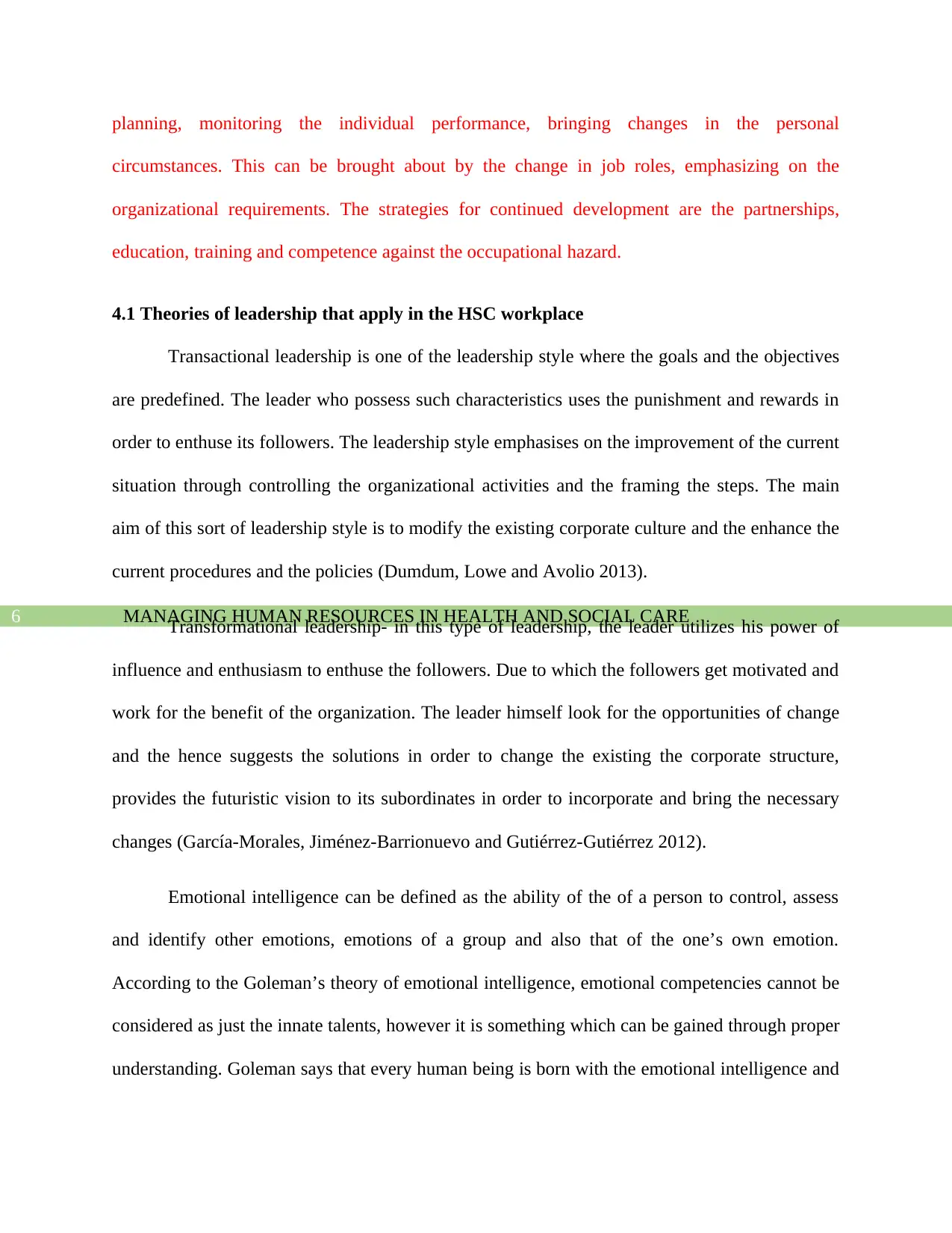
MANAGING HUMAN RESOURCES IN HEALTH AND SOCIAL CARE6
planning, monitoring the individual performance, bringing changes in the personal
circumstances. This can be brought about by the change in job roles, emphasizing on the
organizational requirements. The strategies for continued development are the partnerships,
education, training and competence against the occupational hazard.
4.1 Theories of leadership that apply in the HSC workplace
Transactional leadership is one of the leadership style where the goals and the objectives
are predefined. The leader who possess such characteristics uses the punishment and rewards in
order to enthuse its followers. The leadership style emphasises on the improvement of the current
situation through controlling the organizational activities and the framing the steps. The main
aim of this sort of leadership style is to modify the existing corporate culture and the enhance the
current procedures and the policies (Dumdum, Lowe and Avolio 2013).
Transformational leadership- in this type of leadership, the leader utilizes his power of
influence and enthusiasm to enthuse the followers. Due to which the followers get motivated and
work for the benefit of the organization. The leader himself look for the opportunities of change
and the hence suggests the solutions in order to change the existing the corporate structure,
provides the futuristic vision to its subordinates in order to incorporate and bring the necessary
changes (García-Morales, Jiménez-Barrionuevo and Gutiérrez-Gutiérrez 2012).
Emotional intelligence can be defined as the ability of the of a person to control, assess
and identify other emotions, emotions of a group and also that of the one’s own emotion.
According to the Goleman’s theory of emotional intelligence, emotional competencies cannot be
considered as just the innate talents, however it is something which can be gained through proper
understanding. Goleman says that every human being is born with the emotional intelligence and
planning, monitoring the individual performance, bringing changes in the personal
circumstances. This can be brought about by the change in job roles, emphasizing on the
organizational requirements. The strategies for continued development are the partnerships,
education, training and competence against the occupational hazard.
4.1 Theories of leadership that apply in the HSC workplace
Transactional leadership is one of the leadership style where the goals and the objectives
are predefined. The leader who possess such characteristics uses the punishment and rewards in
order to enthuse its followers. The leadership style emphasises on the improvement of the current
situation through controlling the organizational activities and the framing the steps. The main
aim of this sort of leadership style is to modify the existing corporate culture and the enhance the
current procedures and the policies (Dumdum, Lowe and Avolio 2013).
Transformational leadership- in this type of leadership, the leader utilizes his power of
influence and enthusiasm to enthuse the followers. Due to which the followers get motivated and
work for the benefit of the organization. The leader himself look for the opportunities of change
and the hence suggests the solutions in order to change the existing the corporate structure,
provides the futuristic vision to its subordinates in order to incorporate and bring the necessary
changes (García-Morales, Jiménez-Barrionuevo and Gutiérrez-Gutiérrez 2012).
Emotional intelligence can be defined as the ability of the of a person to control, assess
and identify other emotions, emotions of a group and also that of the one’s own emotion.
According to the Goleman’s theory of emotional intelligence, emotional competencies cannot be
considered as just the innate talents, however it is something which can be gained through proper
understanding. Goleman says that every human being is born with the emotional intelligence and
Paraphrase This Document
Need a fresh take? Get an instant paraphrase of this document with our AI Paraphraser
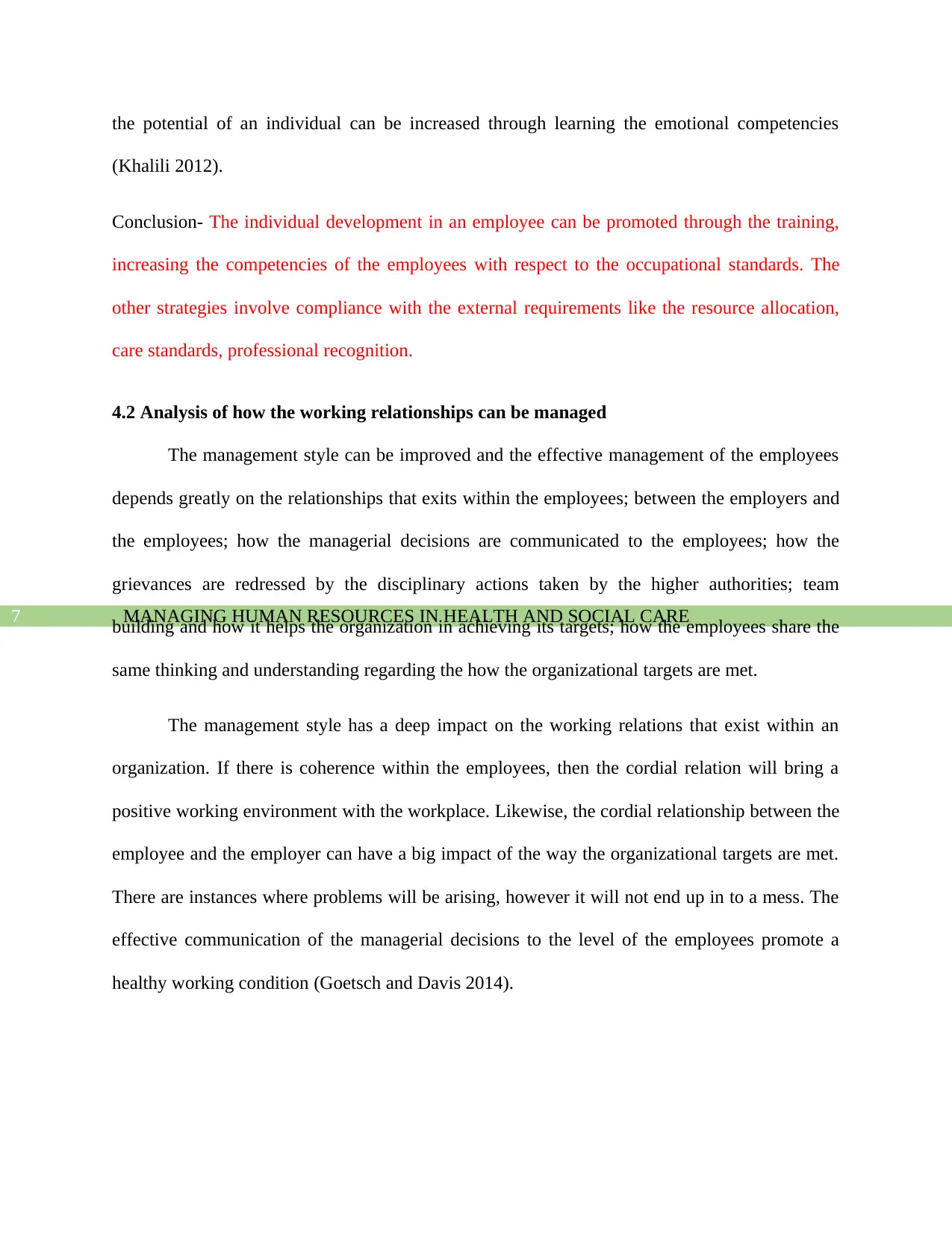
MANAGING HUMAN RESOURCES IN HEALTH AND SOCIAL CARE7
the potential of an individual can be increased through learning the emotional competencies
(Khalili 2012).
Conclusion- The individual development in an employee can be promoted through the training,
increasing the competencies of the employees with respect to the occupational standards. The
other strategies involve compliance with the external requirements like the resource allocation,
care standards, professional recognition.
4.2 Analysis of how the working relationships can be managed
The management style can be improved and the effective management of the employees
depends greatly on the relationships that exits within the employees; between the employers and
the employees; how the managerial decisions are communicated to the employees; how the
grievances are redressed by the disciplinary actions taken by the higher authorities; team
building and how it helps the organization in achieving its targets; how the employees share the
same thinking and understanding regarding the how the organizational targets are met.
The management style has a deep impact on the working relations that exist within an
organization. If there is coherence within the employees, then the cordial relation will bring a
positive working environment with the workplace. Likewise, the cordial relationship between the
employee and the employer can have a big impact of the way the organizational targets are met.
There are instances where problems will be arising, however it will not end up in to a mess. The
effective communication of the managerial decisions to the level of the employees promote a
healthy working condition (Goetsch and Davis 2014).
the potential of an individual can be increased through learning the emotional competencies
(Khalili 2012).
Conclusion- The individual development in an employee can be promoted through the training,
increasing the competencies of the employees with respect to the occupational standards. The
other strategies involve compliance with the external requirements like the resource allocation,
care standards, professional recognition.
4.2 Analysis of how the working relationships can be managed
The management style can be improved and the effective management of the employees
depends greatly on the relationships that exits within the employees; between the employers and
the employees; how the managerial decisions are communicated to the employees; how the
grievances are redressed by the disciplinary actions taken by the higher authorities; team
building and how it helps the organization in achieving its targets; how the employees share the
same thinking and understanding regarding the how the organizational targets are met.
The management style has a deep impact on the working relations that exist within an
organization. If there is coherence within the employees, then the cordial relation will bring a
positive working environment with the workplace. Likewise, the cordial relationship between the
employee and the employer can have a big impact of the way the organizational targets are met.
There are instances where problems will be arising, however it will not end up in to a mess. The
effective communication of the managerial decisions to the level of the employees promote a
healthy working condition (Goetsch and Davis 2014).
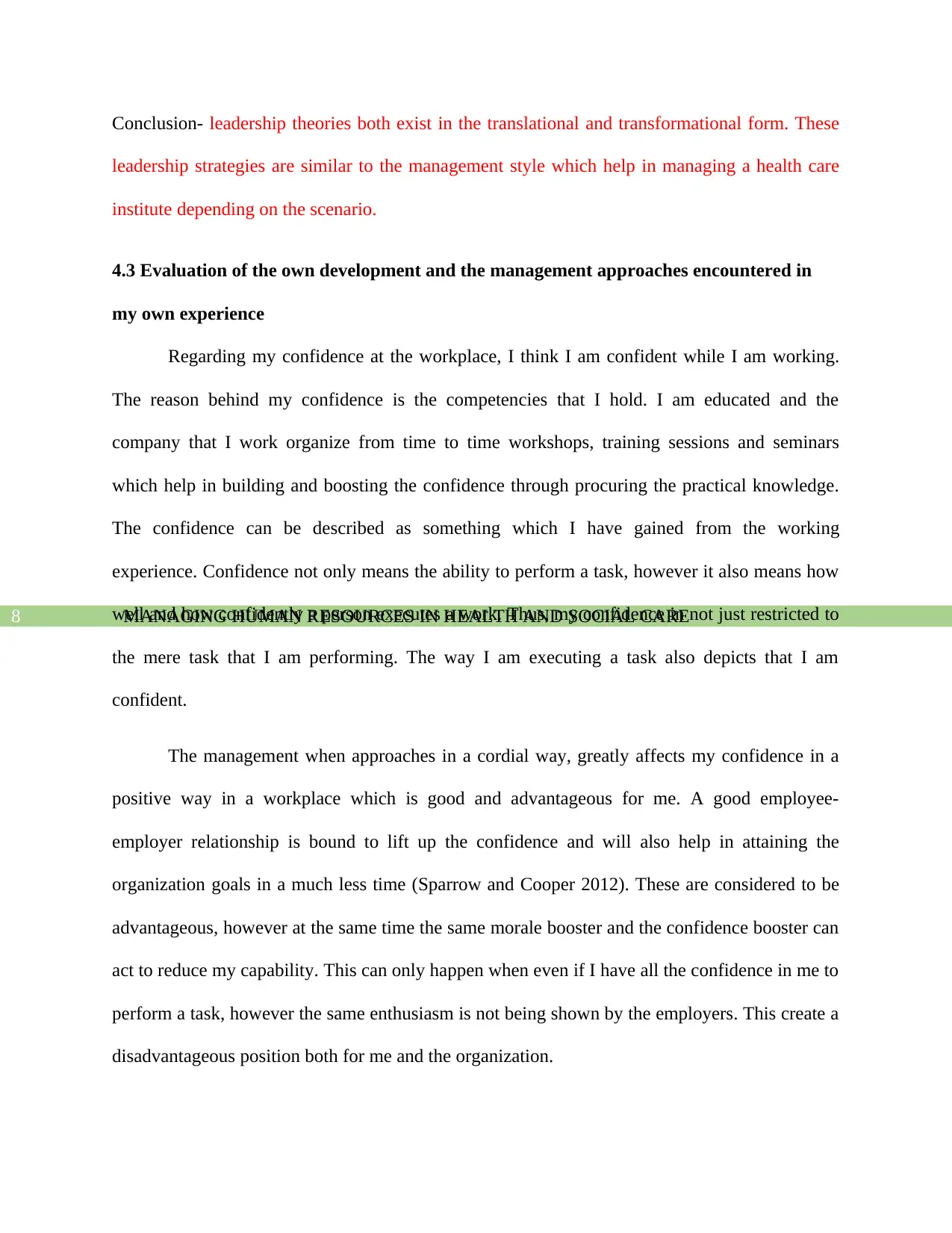
MANAGING HUMAN RESOURCES IN HEALTH AND SOCIAL CARE8
Conclusion- leadership theories both exist in the translational and transformational form. These
leadership strategies are similar to the management style which help in managing a health care
institute depending on the scenario.
4.3 Evaluation of the own development and the management approaches encountered in
my own experience
Regarding my confidence at the workplace, I think I am confident while I am working.
The reason behind my confidence is the competencies that I hold. I am educated and the
company that I work organize from time to time workshops, training sessions and seminars
which help in building and boosting the confidence through procuring the practical knowledge.
The confidence can be described as something which I have gained from the working
experience. Confidence not only means the ability to perform a task, however it also means how
well and how confidently a person executes a work. Thus, my confidence in not just restricted to
the mere task that I am performing. The way I am executing a task also depicts that I am
confident.
The management when approaches in a cordial way, greatly affects my confidence in a
positive way in a workplace which is good and advantageous for me. A good employee-
employer relationship is bound to lift up the confidence and will also help in attaining the
organization goals in a much less time (Sparrow and Cooper 2012). These are considered to be
advantageous, however at the same time the same morale booster and the confidence booster can
act to reduce my capability. This can only happen when even if I have all the confidence in me to
perform a task, however the same enthusiasm is not being shown by the employers. This create a
disadvantageous position both for me and the organization.
Conclusion- leadership theories both exist in the translational and transformational form. These
leadership strategies are similar to the management style which help in managing a health care
institute depending on the scenario.
4.3 Evaluation of the own development and the management approaches encountered in
my own experience
Regarding my confidence at the workplace, I think I am confident while I am working.
The reason behind my confidence is the competencies that I hold. I am educated and the
company that I work organize from time to time workshops, training sessions and seminars
which help in building and boosting the confidence through procuring the practical knowledge.
The confidence can be described as something which I have gained from the working
experience. Confidence not only means the ability to perform a task, however it also means how
well and how confidently a person executes a work. Thus, my confidence in not just restricted to
the mere task that I am performing. The way I am executing a task also depicts that I am
confident.
The management when approaches in a cordial way, greatly affects my confidence in a
positive way in a workplace which is good and advantageous for me. A good employee-
employer relationship is bound to lift up the confidence and will also help in attaining the
organization goals in a much less time (Sparrow and Cooper 2012). These are considered to be
advantageous, however at the same time the same morale booster and the confidence booster can
act to reduce my capability. This can only happen when even if I have all the confidence in me to
perform a task, however the same enthusiasm is not being shown by the employers. This create a
disadvantageous position both for me and the organization.
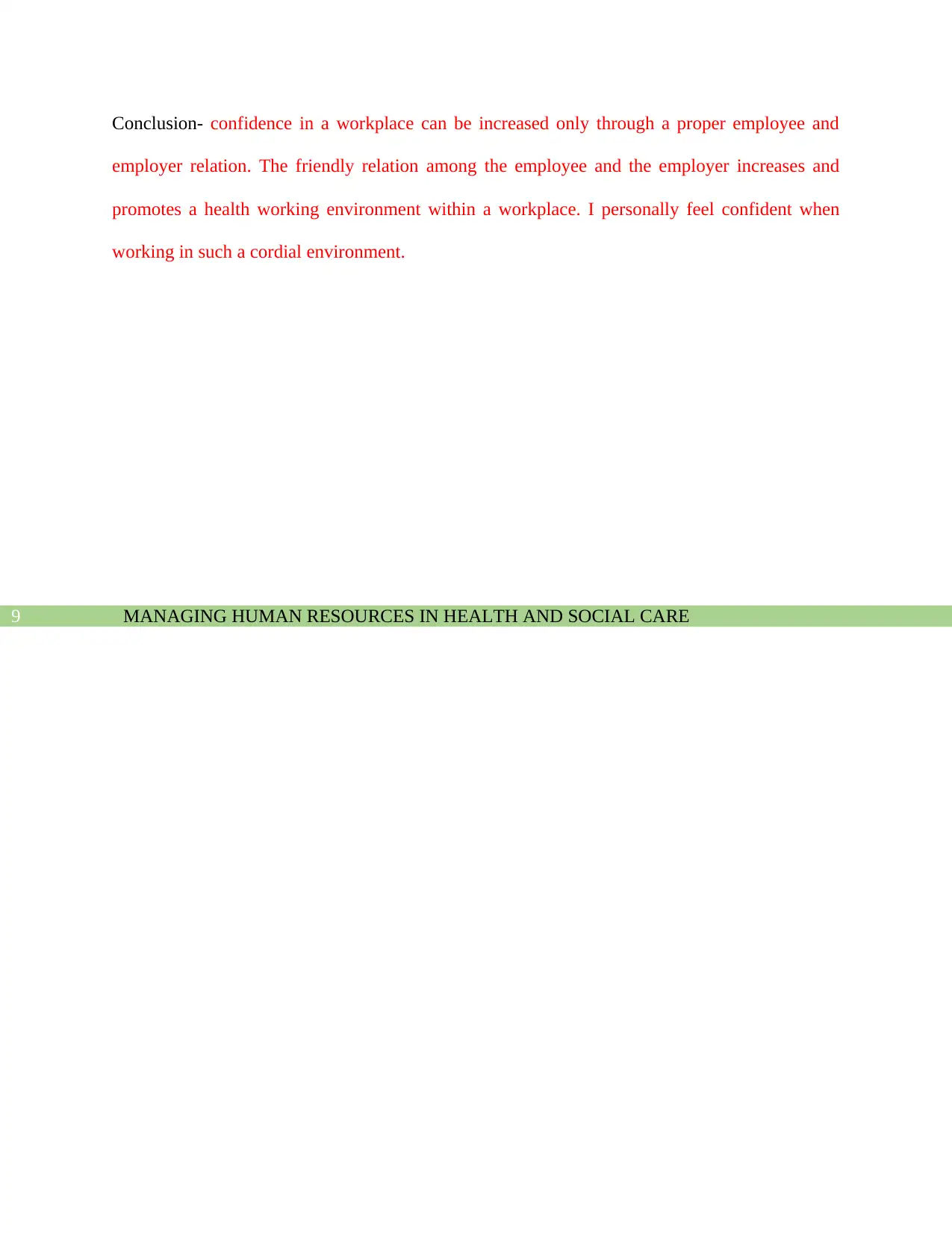
MANAGING HUMAN RESOURCES IN HEALTH AND SOCIAL CARE9
Conclusion- confidence in a workplace can be increased only through a proper employee and
employer relation. The friendly relation among the employee and the employer increases and
promotes a health working environment within a workplace. I personally feel confident when
working in such a cordial environment.
Conclusion- confidence in a workplace can be increased only through a proper employee and
employer relation. The friendly relation among the employee and the employer increases and
promotes a health working environment within a workplace. I personally feel confident when
working in such a cordial environment.
Secure Best Marks with AI Grader
Need help grading? Try our AI Grader for instant feedback on your assignments.
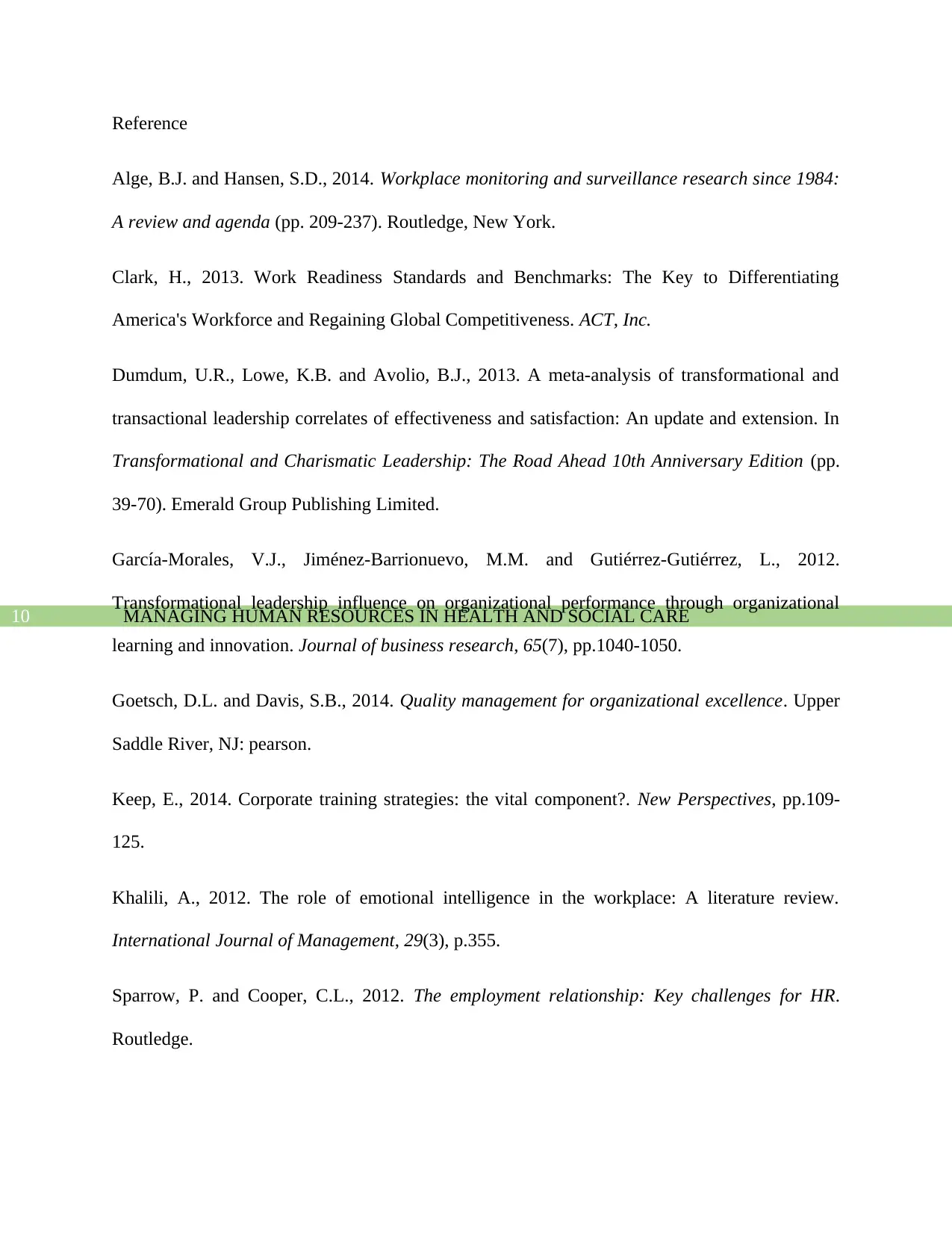
MANAGING HUMAN RESOURCES IN HEALTH AND SOCIAL CARE10
Reference
Alge, B.J. and Hansen, S.D., 2014. Workplace monitoring and surveillance research since 1984:
A review and agenda (pp. 209-237). Routledge, New York.
Clark, H., 2013. Work Readiness Standards and Benchmarks: The Key to Differentiating
America's Workforce and Regaining Global Competitiveness. ACT, Inc.
Dumdum, U.R., Lowe, K.B. and Avolio, B.J., 2013. A meta-analysis of transformational and
transactional leadership correlates of effectiveness and satisfaction: An update and extension. In
Transformational and Charismatic Leadership: The Road Ahead 10th Anniversary Edition (pp.
39-70). Emerald Group Publishing Limited.
García-Morales, V.J., Jiménez-Barrionuevo, M.M. and Gutiérrez-Gutiérrez, L., 2012.
Transformational leadership influence on organizational performance through organizational
learning and innovation. Journal of business research, 65(7), pp.1040-1050.
Goetsch, D.L. and Davis, S.B., 2014. Quality management for organizational excellence. Upper
Saddle River, NJ: pearson.
Keep, E., 2014. Corporate training strategies: the vital component?. New Perspectives, pp.109-
125.
Khalili, A., 2012. The role of emotional intelligence in the workplace: A literature review.
International Journal of Management, 29(3), p.355.
Sparrow, P. and Cooper, C.L., 2012. The employment relationship: Key challenges for HR.
Routledge.
Reference
Alge, B.J. and Hansen, S.D., 2014. Workplace monitoring and surveillance research since 1984:
A review and agenda (pp. 209-237). Routledge, New York.
Clark, H., 2013. Work Readiness Standards and Benchmarks: The Key to Differentiating
America's Workforce and Regaining Global Competitiveness. ACT, Inc.
Dumdum, U.R., Lowe, K.B. and Avolio, B.J., 2013. A meta-analysis of transformational and
transactional leadership correlates of effectiveness and satisfaction: An update and extension. In
Transformational and Charismatic Leadership: The Road Ahead 10th Anniversary Edition (pp.
39-70). Emerald Group Publishing Limited.
García-Morales, V.J., Jiménez-Barrionuevo, M.M. and Gutiérrez-Gutiérrez, L., 2012.
Transformational leadership influence on organizational performance through organizational
learning and innovation. Journal of business research, 65(7), pp.1040-1050.
Goetsch, D.L. and Davis, S.B., 2014. Quality management for organizational excellence. Upper
Saddle River, NJ: pearson.
Keep, E., 2014. Corporate training strategies: the vital component?. New Perspectives, pp.109-
125.
Khalili, A., 2012. The role of emotional intelligence in the workplace: A literature review.
International Journal of Management, 29(3), p.355.
Sparrow, P. and Cooper, C.L., 2012. The employment relationship: Key challenges for HR.
Routledge.
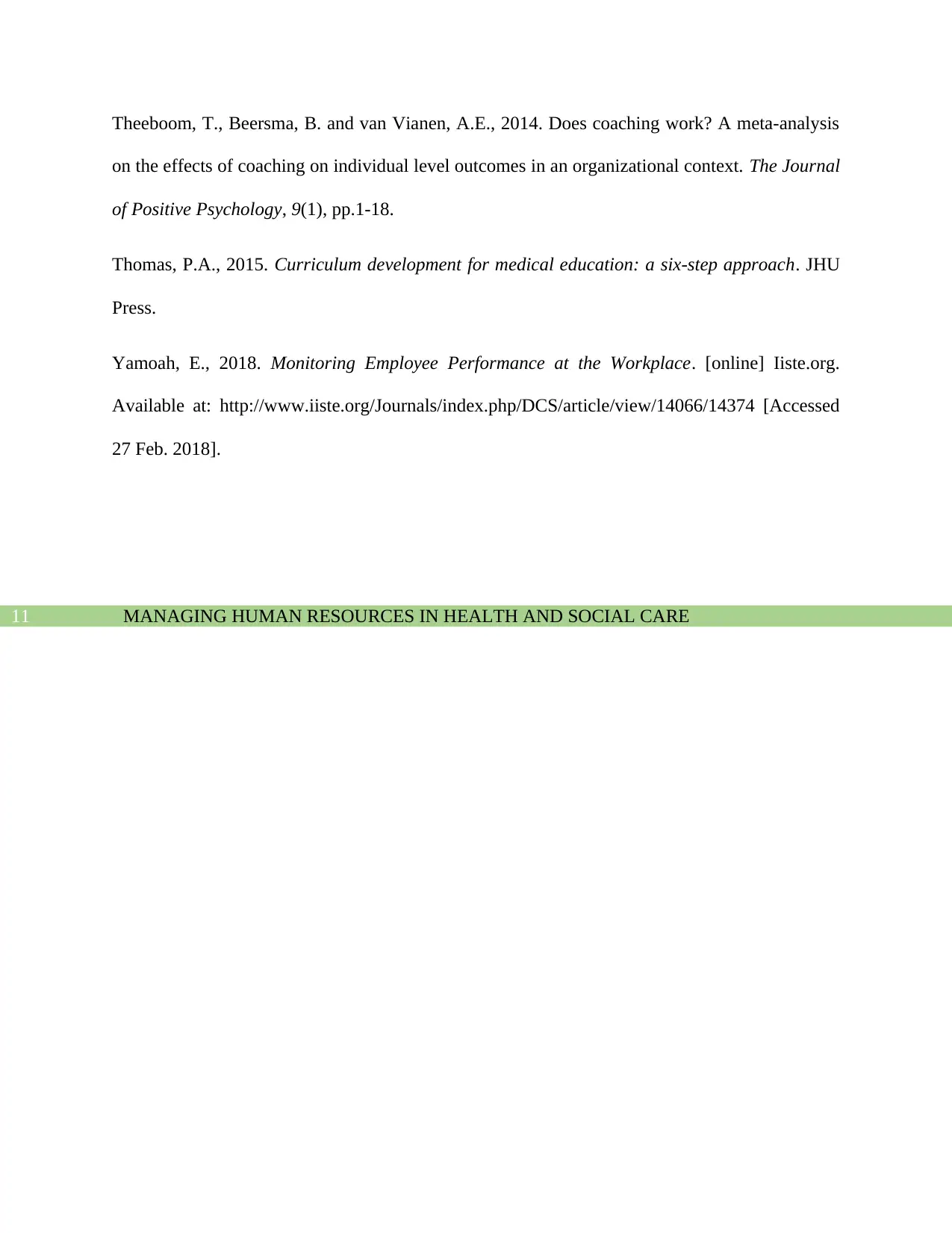
MANAGING HUMAN RESOURCES IN HEALTH AND SOCIAL CARE11
Theeboom, T., Beersma, B. and van Vianen, A.E., 2014. Does coaching work? A meta-analysis
on the effects of coaching on individual level outcomes in an organizational context. The Journal
of Positive Psychology, 9(1), pp.1-18.
Thomas, P.A., 2015. Curriculum development for medical education: a six-step approach. JHU
Press.
Yamoah, E., 2018. Monitoring Employee Performance at the Workplace. [online] Iiste.org.
Available at: http://www.iiste.org/Journals/index.php/DCS/article/view/14066/14374 [Accessed
27 Feb. 2018].
Theeboom, T., Beersma, B. and van Vianen, A.E., 2014. Does coaching work? A meta-analysis
on the effects of coaching on individual level outcomes in an organizational context. The Journal
of Positive Psychology, 9(1), pp.1-18.
Thomas, P.A., 2015. Curriculum development for medical education: a six-step approach. JHU
Press.
Yamoah, E., 2018. Monitoring Employee Performance at the Workplace. [online] Iiste.org.
Available at: http://www.iiste.org/Journals/index.php/DCS/article/view/14066/14374 [Accessed
27 Feb. 2018].
1 out of 12
Related Documents
Your All-in-One AI-Powered Toolkit for Academic Success.
+13062052269
info@desklib.com
Available 24*7 on WhatsApp / Email
![[object Object]](/_next/static/media/star-bottom.7253800d.svg)
Unlock your academic potential
© 2024 | Zucol Services PVT LTD | All rights reserved.





